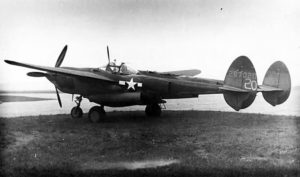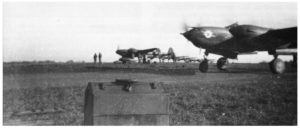[Created on 11/23/20, this post has now been updated to include an illustration of Lt. Col. Jack S. Jenkins in his P-38H.]
Autumn Over Europe – The “Flying Wolf” Identified
(A brief “intermission” in Major Joel’s story…)
In this series of blog posts about Major Milton Joel, Part IV (Part 1), “Autumn Over Europe” displays three photographs of P-38H Lightning 42-67020. This aircraft served as Major Joel’s personal plane, and eventually carried his personal insignia (sans actual nickname) of a “flying wolf” in the form of a P-38. He piloted this aircraft on what proved to be his final mission over Europe, on November 29, 1943 (covered in Missing Air Crew Report 1429), as recounted in “A Monday in November“.
As I wrote in Part 1 of “Autumn Over Europe”, “As for Major Joel’s aircraft, Sergeant [Robert T.] Sand completed the insignia about 18 November, eleven days before Major Joel was shot down. Paralleling the central mystery of what actually happened to Major Joel, there lies a minor mystery: The specific “identity” – the squadron identification letter – of the flying wolf. Unfortunately, typical of the great majority of MACRs for 8th Air Force fighter losses (the 355th Fighter Group being a notable exception), MACRs for 55th Fighter Group planes did not record specific aircraft squadron letters. Similarly, while the Squadron’s Mission Reports list the full names and serial numbers of pilots and their “positions” in squadron formations, both aircraft identification letters and aircraft serial numbers are absent from these documents.”
And there, I thought the small puzzle about the “flying wolf’s” identification would forever remain. But, no sooner had this part Major Joel’s story been posted to the Internet, then I received the following communication from Bruce Klein:
“After reading this excellent post on Major Milton Joel, I decided to go to the Critical Past website to take a closer look at the films included in the post.
Looking at the pictures from this film: P-38 aircraft of the U.S. 55th Fighter Group at Nuthampstead Airfield, England, I noticed that the serial number of the P-38H-5 CG-A, shown early in the film, was barely legible, something it is not in the film. Increasing the brightness on my iMac, I was able to make the serial number legible, the serial number of CG-A is 267020, which is the serial number given for Major Joel’s personal P-38.”
Absolutely: Bruce’s detective work is correct!
During the interval of 8 to 12 seconds into the film, the camera pans left to right across hardstands at Nuthampstead. This view moves from P-38H “CG *A” and stops at a distant view of P-38H “CG * J”, the latter being P-38H 42-67074, Colonel Jack Jenkins’ “Texas Ranger”. Since the film is relatively dark and of very high contrast during this time-frame , “CG * A’s” serial isn’t visible. (At first.)
But, when brightness and contrast are adjusted for this screen capture image of “CG * A”, the plane’s serial number clearly emerges.
You can see the plane’s serial on its fins and rudder, in the image below:
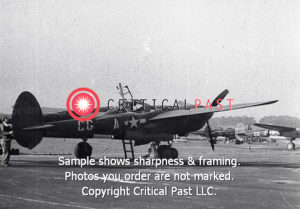 Major Joel’s use of the letter “A” for his plane’s identification code does make sense, for the very first letter of the alphabet would have been intuitively consistent with his having been squadron commander, and as such may have simplified aerial identification, and both air and ground communication. Well, I did previously wonder if the “flying” wolf was the “second” “CG * J” (J for Joel) of the 38th Fighter Sqadron (Colonel Jenkins’ “CG * J” being the first “J”), or “CG * M” (M for Milton), but evidently, not! (Given the stencil lines in the letters “C”, G”, and “A”, the squadron code letters were probably painted shortly before this scene was filmed. It seems that Major Joel’s ground crew hadn’t yet completed the finishing touches to the plane’s markings.)
Major Joel’s use of the letter “A” for his plane’s identification code does make sense, for the very first letter of the alphabet would have been intuitively consistent with his having been squadron commander, and as such may have simplified aerial identification, and both air and ground communication. Well, I did previously wonder if the “flying” wolf was the “second” “CG * J” (J for Joel) of the 38th Fighter Sqadron (Colonel Jenkins’ “CG * J” being the first “J”), or “CG * M” (M for Milton), but evidently, not! (Given the stencil lines in the letters “C”, G”, and “A”, the squadron code letters were probably painted shortly before this scene was filmed. It seems that Major Joel’s ground crew hadn’t yet completed the finishing touches to the plane’s markings.)
________________________________________
So, here again are captionless three images of the “flying wolf”, as featured (and fully captioned) in Part IV (Part 1) of the post “Autumn Over Europe“.
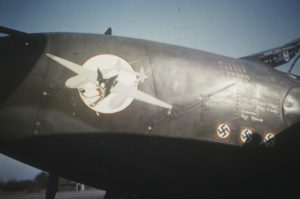 ________________________________________
________________________________________
Here’s the Critical Past video clip that’s featured in Part IV (Part 1) of the blog post “Autumn Over Europe“, but here, with an updated caption.
This video, clip: 65675030628, is entitled “P-38 aircraft of the U.S. 55th Fighter Group at Nuthampstead Airfield, England”.
Though a description of the film is available at Critical Past, here’s a much more detailed breakdown of the scenes in the film:
0:04 – 0:08: General view of 343rd Fighter Squadron P-38s
0:08 – 0:12: General view of 38th FS P-38s being prepared for a mission. Major Joel’s P-38H 42-67020 “CG * A”, at left, and then, camera pans to Colonel Jenkin’s P-38H 42-67074 “CG * J” “Texas Ranger” in distance, at right.
0:13 – 0:28: Close-up of a P-38. Ground crewman loads parachute and dinghy in cockpit, another attends to .50 machine guns, another closes canopy, another examines engine plumbing and buttons up access panels.
0:28 – 0:34: An armorer cleans the barrel of the P-38’s 20mm cannon.
0:34 – 0:36: Finishing touches on the P-38.
0:36 – 1:12: Group Commander Colonel Frank James (standing at far left) briefs 38th Fighter Squadron pilots prior to the mission.
0:47 – 1:11: Audio recording of Colonel James’ pre-mission briefing.
In this scene, a total of 21 pilots are visible besides Colonel James. Though this video is low of resolution and it’s probably impossible to correlate “names to faces” 77 years later (as if anyone would be remembered by now!), eleven men in the group are definitely members of the 38th Fighter Squadron.
They are:
Major Joel
Capt. Mark K. Shipman
1 Lt. Jerry H. Ayers
1 Lt. James H. Hancock
1 Lt. Joseph Myers
1 Lt. Gerald F. Leinweber
1 Lt. Morris Leve
1 Lt. Wilton E. Wyche
2 Lt. Gerald Brown
2 Lt. Hugh E. Gillette (replaced on the mission by 2 Lt. Allen R. Peters)
2 Lt. Delorn L. Steiner
…and…
Lt. Colonel Jack S. Jenkins
…thus, the remaining 10 pilots are presumably members of the 338th or 343rd Fighter Squadrons, or possibly, the 20th Fighter Group.
Other scenes show:
1:13 – 1:20: Lt. Colonel Jenkins climbs into Texas Ranger. The aircraft can be identified by the nose art, which is visible in this Photoshopifically tweaked still image from Critical Past.
 Here’s a high-resolution image of Lt. Col. Jenkins, albeit not in this film. This picture can be found at the five-page HyperScale Forum discussion “What is a visual difference between the P-38G and H?” It’s one of six images pertaining to the design and construction of the rear canopy in early P-38s, all posted on August 16, 2019 by John Clements.
Here’s a high-resolution image of Lt. Col. Jenkins, albeit not in this film. This picture can be found at the five-page HyperScale Forum discussion “What is a visual difference between the P-38G and H?” It’s one of six images pertaining to the design and construction of the rear canopy in early P-38s, all posted on August 16, 2019 by John Clements.
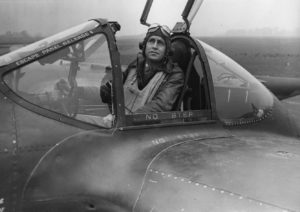 This photo appeared in the Daily News (New York City) on March 4, 1944, in conjunction with news reports about the first appearance of USAAF fighter escorts over Berlin.
This photo appeared in the Daily News (New York City) on March 4, 1944, in conjunction with news reports about the first appearance of USAAF fighter escorts over Berlin.
 Lt. Col. Jenkins presumably piloted a P-38J on that mission. He was shot down and captured a little over a month later – on April 10 – while flying “Texas Ranger IV”, a P-38J (42-67825). That plane’s downing and his capture are covered in MACR 3620 and Luftgaukommando Report J 840. The last 8th Air Force P-38H lost in combat, at least for which there’s a MACR, was flown by 1 Lt. William E. Harbert of the 338th FS, and downed on January 11, 1944. Unfortunately, Harbert did not survive.
Lt. Col. Jenkins presumably piloted a P-38J on that mission. He was shot down and captured a little over a month later – on April 10 – while flying “Texas Ranger IV”, a P-38J (42-67825). That plane’s downing and his capture are covered in MACR 3620 and Luftgaukommando Report J 840. The last 8th Air Force P-38H lost in combat, at least for which there’s a MACR, was flown by 1 Lt. William E. Harbert of the 338th FS, and downed on January 11, 1944. Unfortunately, Harbert did not survive.
1:20 – 1:22: The “business end” of Texas Ranger.
1:23 – 1:26: Lt. Colonel Jenkins fires up Texas Ranger’s engines.
1:27 – 1:32: P-38H CG * O taxies out.
1:33 – 1:44: Texas Ranger taxies out.
In closing, thanks very much for your help, Bruce.
Next: Part V – A Monday in November: Major Joel’s Last Mission

